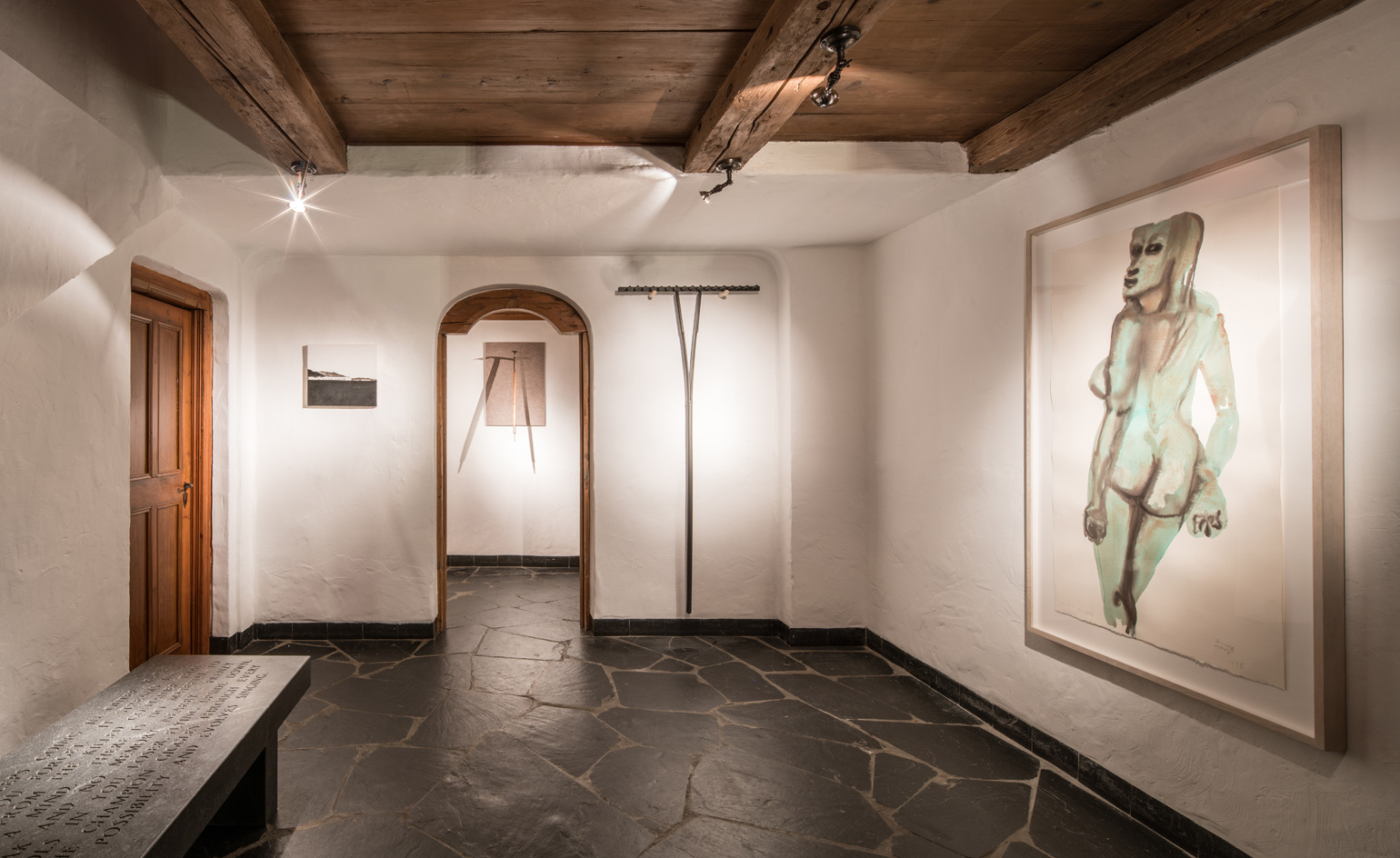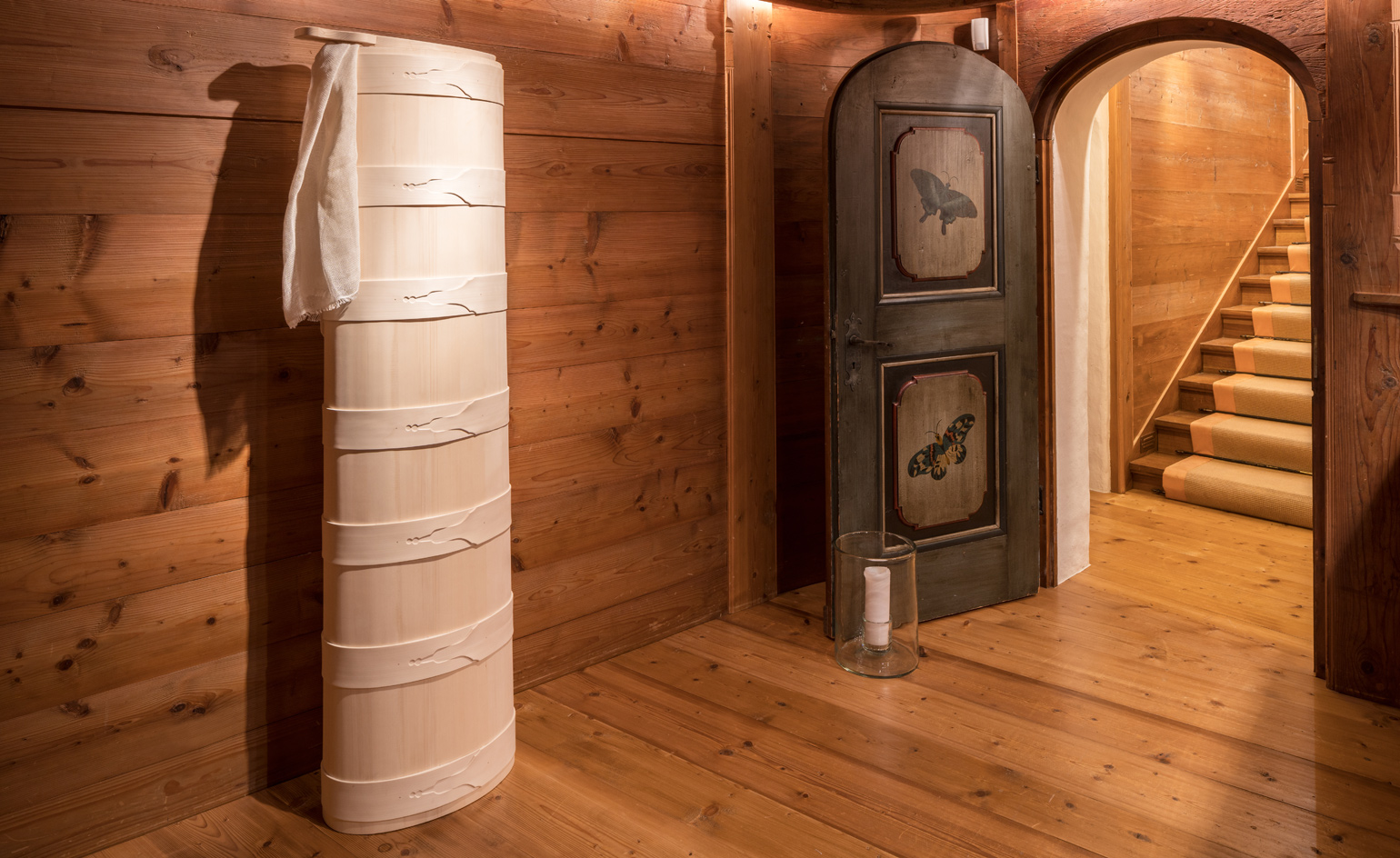Cold play: Rolf Sachs conjures an alpine adventure in a Swiss chalet

An ash wood sled stands sentinel outside of a traditional Swiss chalet, looming comically over the front door at four metres tall. It seems poised for the slopes – surely the home’s inhabitants are having a laugh?
In fact, it’s an artwork by the Swiss artist Rolf Sachs, heralding his exhibition at the Vieux Chalet in Gstaad, Switzerland. Presented in collaboration with Hauser & Wirth, the show explores alpine culture through a series of sculpture, portraiture, and site-specific installations. For the Lausanne-born, London-based artist, ‘Alpine culture comes with a certain ease,’ he says.
Sachs’ Rasté (2012) – a handsome rake, hand-carved from slate – is the first to greet visitors in the foyer. Framed through an archway behind, an ice pick defiantly pierces a piece of thick felt – the absurdist juxtaposition here is crucial to Sachs’ visual language.
The chalet is lavishly decorated and finding Sachs’ work amongst the trove of mountain-kitsch furnishings becomes a delightful game in itself. So much so, a guest placed his hat on a €20,000 artwork on the opening night, mistaking it for a coat hook.
But it’s all very much in the spirit of the work, and Sachs’ chameleonic pieces live as comfortably in the home as the furniture. ‘That is the point,’ he says. ‘For instance, the rake could have been a real one from 100 years ago. It was an essential tool for the valley and might have hung [in the foyer] for all we know. On top of that I like the aesthetics, I made it in stone to give it a sculptural value.’
In the living room, Alberto Giacometti’s sculptural works flank Sachs’ powerful site-specific intervention Rocks (2016) – a harmonious, wall-hung arrangement of stones handpicked by the artist from the local mountain region. ‘The stones have an incredibly strong presence. It boils down the creative process to the bare minimum’ explains the artist of the work, adding, ‘Nature is the most beautiful sculpture.’
Hanging next to an imposing stone fireplace nearby: a pair of small silhouette portraits, one of Sachs, the other of his late father. It’s an especially revealing piece: Vieux Chalet once belonged to Sachs’ father, Gunter Sachs, a renowned photographer, industrialist, author and avid art collector. Here, local artist Beatrice Straubhaar was commissioned by Sachs to create a modern rendition of Scherenschnitt (or scissor-cut), a traditional craft in Germany and Switzerland popular during the 19th century and Goethe era.
Elsewhere, Sachs continues this tribute to local Swiss craft and agricultural iconography. He pays homage to Brancusi’s Endless Column with a stack of Motteli (wooden food vessels) produced using an old Swiss wood working method; gets spiritual in Bet(t)ruf (2016), creating a sculpture from the milk funnels (Folle) used to call prayers in the evening; and illuminates a room with a starry effect, using a perforated milk churn and bucket.
Sachs is often described as an artist/designer, but it’s a label that belies him. Certainly, many of the works are flawless specimens of craftsmanship. But in the end, design is simply his artistic medium of choice.
The exhibition is scattered throughout the labyrinthine chalet, forming a dialogue with both his father’s home and works by Hauser & Wirth artists. A mezzanine overlooking the living room houses Hay Fling (2016), capturing a handful of hay frozen joyfully in mid-air. The view from the mezzanine also reveals a subtle video installation embedded in the window frame – a soothing snowfall that can be seen from inside and outside – which Sachs describes as ‘very spiritual’.
In the evening, the chalet is lit up outside by a site-specific neon installation, which mimics water flowing from a rain gutter using a long strip of blue neon while a steel bucket catches the light below. After a hard day out in the elements, Sachs’ warm-hearted alpine delights are the perfect antidote to the cold.

Sachs’ Rasté (centre), 2012 – a handsome rake, hand-carved from slate – is the first to greet visitors in the foyer

Nearby, an ice pick defiantly pierces a piece of thick felt in Untitled (2nd edition), 2016

Rocks, 2016, is a powerful arrangement of stones, handpicked by the artist from the local mountain region and hung harmoniously on the wall

Leise rieselt der Schnee, 2016. A video installation is subtly embedded in the window frame, depicting a soothing film of snowfall (captured by Sachs in the Engadin region), which can be seen from inside and outside

Pouring light - Saahne, 2016, comprises a perforated milk churn and bucket sourced from the Alpine region of Emmenthal. The illumination from within creates a 'pin-hole' camera effect

Sachs nods to positive childhood memories with Gaudi, 2013, a light-hearted interpretation of the classical wooden sled

Unschuld, 2015. These objects were traditionally used to transport milk from the mountainside, where the cows grazed. Here, Sachs has transformed them into a totem, complete with a cheese cloth

The exhibition is presented in collaboration with Hauser & Wirth, and works from its stable of artists . Bet(t)ruf, 2016 (left) and insepera-able (2nd edition), 2012 (foreground) flank a Paul McCarthy sculpture

In Bet(t)ruf, 2016, Sachs creates a sculpture from the milk funnels used to call prayers in the evening

In the evening, the chalet is lit up outside by a site-specific neon installation, Ewiger Lauf, 2012, which mimics water flowing from a rain gutter using a long strip of blue neon while a steel bucket catches the light below
INFORMATION
The exhibition is on view at Vieux Chalet in Gstaad until 18 February. Open by appointment only. For more information, visit Rolf Sachs' website
Photography: Jon Etter
Wallpaper* Newsletter
Receive our daily digest of inspiration, escapism and design stories from around the world direct to your inbox.
-
 A Xingfa cement factory’s reimagining breathes new life into an abandoned industrial site
A Xingfa cement factory’s reimagining breathes new life into an abandoned industrial siteWe tour the Xingfa cement factory in China, where a redesign by landscape specialist SWA Group completely transforms an old industrial site into a lush park
By Daven Wu
-
 Put these emerging artists on your radar
Put these emerging artists on your radarThis crop of six new talents is poised to shake up the art world. Get to know them now
By Tianna Williams
-
 Dining at Pyrá feels like a Mediterranean kiss on both cheeks
Dining at Pyrá feels like a Mediterranean kiss on both cheeksDesigned by House of Dré, this Lonsdale Road addition dishes up an enticing fusion of Greek and Spanish cooking
By Sofia de la Cruz
-
 Switzerland’s best art exhibitions to see in 2025
Switzerland’s best art exhibitions to see in 2025Art fans, here’s your bucket list of the standout exhibitions to see in Switzerland in 2025, exploring compelling themes and diverse media
By Simon Mills
-
 Inside the distorted world of artist George Rouy
Inside the distorted world of artist George RouyFrequently drawing comparisons with Francis Bacon, painter George Rouy is gaining peer points for his use of classic techniques to distort the human form
By Hannah Silver
-
 Out of office: what the Wallpaper* editors have been doing this week
Out of office: what the Wallpaper* editors have been doing this weekA snowy Swiss Alpine sleepover, a design book fest in Milan, and a night with Steve Coogan in London – our editors' out-of-hours adventures this week
By Bill Prince
-
 Inside Jack Whitten’s contribution to American contemporary art
Inside Jack Whitten’s contribution to American contemporary artAs Jack Whitten exhibition ‘Speedchaser’ opens at Hauser & Wirth, London, and before a major retrospective at MoMA opens next year, we explore the American artist's impact
By Finn Blythe
-
 The lesser-known Los Angeles galleries contributing to a vibrant art scene
The lesser-known Los Angeles galleries contributing to a vibrant art sceneOutside of LACMA, MOCA and The Broad, these independent LA galleries are major players in the art world
By Kevin EG Perry
-
 ‘Happy birthday Louise Parker II’: enter the world of Roe Ethridge
‘Happy birthday Louise Parker II’: enter the world of Roe EthridgeRoe Ethridge speaks of his concurrent Gagosian exhibitions, in Gstaad and London, touching on his fugue approach to photography, fridge doors, and his longstanding collaborator Louise Parker
By Zoe Whitfield
-
 Larry Bell explores the ethereal nature of glass in Monaco
Larry Bell explores the ethereal nature of glass in MonacoLarry Bell's retrospective at Hauser & Wirth, Monaco, unites old and new work
By Finn Blythe
-
 Los Angeles art exhibitions: the best shows to see in April 2025
Los Angeles art exhibitions: the best shows to see in April 2025Read our pick of the best Los Angeles art exhibitions to see this month, from Issy Wood's confession and concealment at Michael Werner Gallery to a Diane Arbus retrospective at David Zwirner
By Carole Dixon